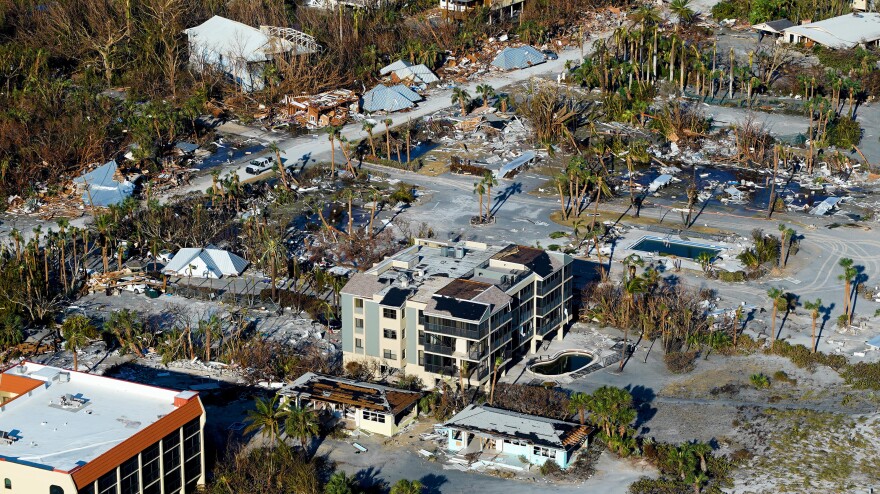The devastation left behind by Hurricane Ian in much of Southwest and Central Florida arrives at a precarious time: a major statewide election, including a high-profile governor’s race, is scheduled to take place a month from now.
The implications of what a widespread disaster could mean for such an important election was the topic of a research paper published this week by the University of Chicago.
The paper looked at the example of Hurricane Michael in 2018, which similarly devastated parts of the Florida Panhandle, and analyzed the impact on voter turnout.
One top-line finding: The storm caused a 7% decline in voter turnout in the eight counties most impacted by the storm.
A difference between the impact of Hurricane Ian and Hurricane Michael is that the 2022 storm hit an area of the state – Southwest Florida – that has a much denser and larger total population. The impact could have electoral ramifications: Lee County, the hardest hit area, is the largest reliably Republican county in the state.
The Florida Constitution (Article VI, Section 5) allows an election to be ”suspended or delayed due to a state of emergency or impending emergency pursuant to general law". But there does not appear to be political will for this to happen post-Hurricane Ian.
As several states postponed elections early on in the COVID-19 pandemic, Governor Ron DeSantis was adamant that Florida would do no such thing. “They voted during the Civil War. We are going to vote,” DeSantis said prior to primary elections in March of 2020.
Mail-in ballots have already been sent out to many voters. In Lee County, the ballots were mailed out on Thursday, October 6, just over a week after the storm.
In a statement on its website, the Lee County Supervisor of Elections said: “If you requested a Vote-by-Mail Ballot and are in an area of Lee County that is not receiving mail or have an alternate address due to the hurricane please call our office to request a replacement ballot at (239) 533-8683.”
Vote-by-mail ballots started to be sent out in neighboring Collier County on September 24th, days before the storm. You can find contact information for your county’s Supervisor of Elections office here.
The following is a short interview with Kevin Morris, who co-authored the new research paper. He is a quantitative researcher with the Brennan Center’s Democracy Program at New York University.

The interview has been lightly edited for clarity.
WLRN: Your research found that in the eight counties most impacted by Hurricane Michael in 2018, there was a 7% drop in voter participation in the 2018 election, which came shortly after. What's the implication of your research as another major hurricane just hit Florida weeks before yet another major midterm election?
MORRIS: Our paper estimates that across the panhandle, more than 13,000 ballots went uncast because of the hurricane. And that's a really major effect. In 2018, the Senate race was decided by just over 10,000 ballots. So if the hurricane depressed turnout by 13,000, that is a really big magnitude. And following Hurricane Ian, we're talking about a much denser area. We could, if the state isn't careful, see really, really big turnout declines.
Part of it is that after a hurricane, we know the bad weather likely reduces people's participation if their basement is flooded or their grandmother is in the hospital. That can understandably make voting fall lower on the list of priorities following an emergency.
At the same time, we know that the executive order that was issued by the governor in 2018 allowed these counties to close a bunch of polling places, but didn't provide any emergency funding to try and erect emergency polling places. So our research tried to unpack how much of that 7 percentage point decrease in turnout was due to the individual level effects – the flooded basement or grandma in the hospital – and how much was due to the fact that these counties didn't get the resources that they needed and they shut down all the polling places.
And our research shows that most of that decline is because of the closed polling places, is because people had to travel further. So the big takeaway is that as Florida starts to think about and the state government starts to think about, how do they protect the midterms? The key question needs to be how do they keep polling places open?
WLRN: If someone is registered to vote in, say, an island like Sanibel, what could they do? Because it's pretty clear at this point post-hurricane Ian that Sanibel, as it was, is just not going to come back for a very long time, if ever.
MORRIS: Now, it's a great question and the paper can't address things like that. But, you know, one thing that the executive order did do in 2018 that should be on the table again, is: it did loosen mail ballot restrictions because a lot of people were displaced and not residing at the address that they're registered at. They went to stay with family members. Usually you can't have a mail ballot sent to an address other than the one that you're registered at. But the executive order allowed that to happen.
So for the areas that are hardest hit, where folks might not be there right now, there should also be – Florida already has really good voting by mail infrastructure – and that should be that should be loosened as well to reflect the reality of the emergency on the ground right now.
During the COVID emergency in 2020, we also saw other examples of counties around the country setting up drive thru polling and getting really creative when people can't vote inside in the areas that they were planning on doing. So we've got examples from around the country from the last decade of how how that can be done.
WLRN: Out of the eight counties we're talking about in the Florida panhandle, was there any one of them in particular that was almost an outlier, that it saw a larger drop in participation than other counties?
MORRIS: It really tracked very closely with the distance that voters had to travel to the closest polling place, places like Bay County. They got really hard hit by that storm surge. They went from 44 expected polling places down to six. And a lot of those were maintained in the hardest hit areas. And those are the areas where we show that the voters that didn't have to travel much further to the polling place ended up not seeing their turnout decline.






